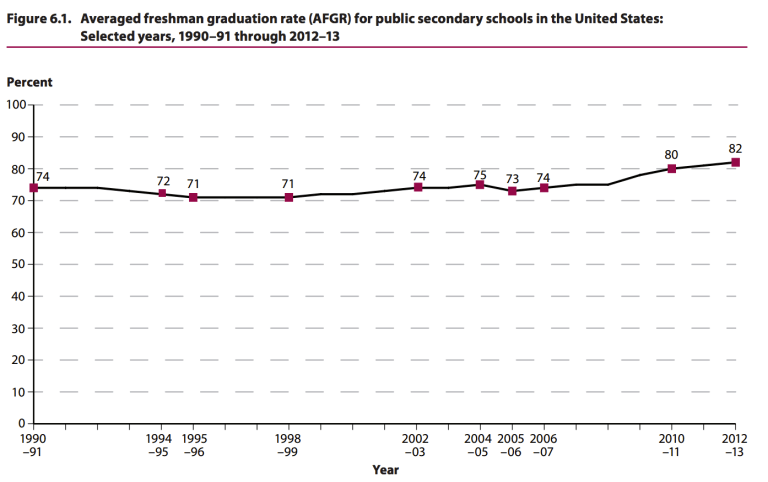
Imagine your doctor tells you that you have an unhealthy condition. You ask what you can do about it. He responds that he doesn’t know. When you return some time later, he tells you your unhealthy condition is improving. You ask what brought on the improvement, and he responds that he doesn’t know. You ask if any studies are going on about the condition. He shrugs and says a few.
High school graduation in the U.S. is like this. First, researchers struggled to understand why it was low and unchanging for a long time. Now, researchers are struggling to understand why it is rising. And there are few studies going on about effective approaches for helping students graduate.
For a young person, graduating from high school is an important milestone of their educational progress, and it has economic implications, too. A recent report estimated that by 2020, 65 percent of jobs will require postsecondary education and training beyond high school. [1] Getting to college means getting through high school.
So, we want the high school graduation rate to be higher—how can it be improved?
The high school graduation rate is complicated
High school graduation is a simple concept, but the high school graduation rate is not. When a school gives a student a high school diploma, it is recorded by the state department of education. That’s the easy part.
To calculate a rate, we need a denominator. We could use the number of twelfth-grade students, but that overstates the true graduation rate because it does not count students who have dropped out. A better denominator would be the number of students who had enrolled in high school four years ago, when most students will not have reached the age at which they legally can stop attending school. Using that denominator yields what is called the ‘four-year graduation rate’ or alternately the ‘on-time graduation rate.’
But four years have elapsed. Some students have moved between states, others moved between districts, and others moved between schools. Suppose a student entered ‘Lincoln High School’ as a ninth grader in, say, fall of 2012. And suppose that student did not enter Lincoln in the fall of 2013. Did the student drop out, or did the student move to another school? The key is whether Lincoln High School receives a ‘request for transfer of school records’ from another high school. If the student enrolls in a new school, a parent or guardian signs a form that that school sends to Lincoln, authorizing Lincoln to send various records to the new school—health and immunization, a transcript, perhaps a year-end report card. That request enables Lincoln High School to count the student as no longer attending the school. Lincoln, in turn, may enroll new students and request records for those students from other high schools.
Tracking the inflows and outflows is called ‘adjusting the cohort.’ The ‘four-year adjusted graduation rate’ is the number of twelfth graders who received diplomas, divided by the total number of ninth graders four years earlier, adjusted for those inflows and outflows. In 2008, the U.S. Department of Education, under Secretary Margaret Spellings, recognized that approaches for measuring high school graduation rates were a mess and put the four-year adjusted graduation rate in place as a new accountability metric under No Child Left Behind. [2] As of 2010, patterns and trends over time in the high school graduation rate now are on the same basis for all states.
The high school graduation rate is going up
A related measure is the ‘averaged freshman graduation rate.’ The National Center for Education Statistics created the measure, which compares the number of graduates in a year to an average of student enrollment in eighth, ninth, and tenth grades four years earlier. This rate uses an average of three years of enrollment to smooth out the bump in ninth grade enrollment that happens because students are retained, but the rate is sensitive to migration trends—for example, if a state or district had more students move out than in, the rate will be too low. [3] But the rate is easily estimated and can be applied to a much longer time period than the adjusted cohort rate, back to 1990. See the figure. [4] The averaged freshman graduation rate was 74 percent in 1990, and it was 74 percent in 2006. Then it began rising.
What happened before 1990? In 2010, James Heckman and Paul LaFontaine published a remarkable paper in which they collated different data sets to overcome flaws in how high school graduation had been measured to that point. [5] Using a common definition they could apply for very long time periods, they found that the high school graduation rate peaked in the early seventies and had not increased as of 2004, when the period covered by their data ended. And gaps between racial and ethnic groups had not closed. Various flawed methods for measuring the rate had obscured these underlying features, especially counting recipients of a General Education Development certificate as high school graduates.
The new ‘average cohort’ accountability metric was implemented at about the time their paper was published, and Civic Enterprises and the Everyone Graduates Center at the Johns Hopkins University have released an annual report using it (the ‘Grad Nation’ report). [6] The report notes that the overall rate in 2015 (the most recent year the data are available) is 83.2 percent, up from 79 percent in 2010, consistent with what the figure shows (the report also compares the average freshman rate and the adjusted cohort rate when both rates were available for three years, and they are close). Recent media reports suggest some reasons to be cautious about higher rates. Alabama overstated its rates because of an administrative oversight, and a recent ProPublica report investigated Florida schools ‘improving’ their graduation rates by moving struggling students to the adult education system. [7] The Grad Nation report argues that the number of young people miscounted as graduates was not large enough to offset the good news.
The recent report also points to issues. The rate of increase has slowed in the last two years, and, as with previous reports, the data show uncomfortably wide disparities for racial and ethnic groups. White and Asian students who are not low-income have graduation rates of 88 percent and 90 percent, respectively. Low-income, Black, or Hispanic students have graduation rates of about 75 percent. One in four of these students does not complete high school. And in 11 states, these students have graduation rates below 70 percent. We should be concerned when more than 30 percent of students fail the K-12 system. Imagine if 30 percent of iPhones had to be returned because they did not work, or 30 percent of new cars could not be driven off the lot.
The report also points to 2,249 high schools that have especially low graduation rates, less than two-thirds of students. These high schools enroll about 900,000 students. The number of low-performing high schools has been falling but it’s many high schools, and, under the Every Student Succeeds Act (ESSA), states and districts need to intervene in these schools. Yes…how?
We don’t have enough research on how to improve high school graduation
In 2013, Richard Murnane published a survey of research on high school graduation. [8] He examined various explanations for why the high school graduation rate was stagnant and then began rising. He concluded that existing evidence is inadequate to explain the trends. And he wrote “…increasing the high school graduation rate in the United States is an important social objective. Yet the evidence on how to accomplish this is remarkably thin.”
As an example of this thin research, Murnane reported that as of 2010, the What Works Clearinghouse (WWC) had reviewed 231 studies in its dropout prevention topic area, of which 27 studies had met standards. As of this writing, seven years later, the WWC reports that it has reviewed 298 studies in its dropout prevention topic area, of which 28 studies met standards. In seven years, the field added one rigorous study to its knowledge base. [9] And 11 of those 28 were done in the 1990s. In comparison, the WWC currently reports 4,469 literacy studies, of which 388 meet standards, numbers that are roughly 14 times larger than for dropout prevention. Literacy is an important topic, but this is a big disparity.
The WWC can rate a study as meeting standards even if the study reports that a program is ineffective, so it’s worth digging down a bit more. Of the 28 studies that met standards, 18 had at least one positive effect on progressing in school or staying in school. But only two were of programs that districts could use as interventions for struggling high schools: a study of the Early College high school program, which provides students the opportunity to simultaneously pursue a high school diploma and earn college credits, and a study of the Check and Connect program, which pairs at-risk students with an adult advocate who monitors their progress and intervenes as needed. [10] To these two we can add MDRC’s study of small high schools in New York City, which also showed positive effects and could be used by districts for struggling high schools. [11] Other studies with positive effects looked at programs such as alternative high schools or the Job Corps program, but these are not interventions to help struggling high schools.
The upshot of the lack of research is that states under ESSA are in a jam. They are required to indicate how they will use evidence-based practices to help struggling high schools but have little to go on. Some states already have submitted draft plans. In various ways, the plans are circular—states will intervene in low-graduation-rate high schools by intervening in them. Connecticut’s plan, for example, is that “any school identified for comprehensive support…will be required to implement more rigorous evidence-based interventions with high statistical probability of success” (page 45). Delaware’s plan calls for districts to have external reviewers assess the needs of low-graduation schools and schools then will implement “additional evidence-based interventions in the school that…are more rigorous and based on strong or moderate levels of evidence” (page 79). Nevada plans to create a list of “state-approved evidence-based service providers” (page 40). [12]
Which is not to criticize the plans. States are working with what they’ve been given. It’s a good idea to use evidence-based practices, but we have a massive imbalance between the size of the problem and the amount of evidence to tackle it.
State authority can co-exist with federal research
ESSA gives states more authority over K-12 education. But we should not confuse authority to plan and deliver education services with authority to plan and deliver education research.
Research generates ’positive externalities’ in the jargon of economists. Any one state has an incentive to invest in research up to the point at which that state values it. But all states might benefit from research in any one state. The net result is that states will under-invest in research from the perspective of the nation. This is true for just about any area of research, and it’s why we have the National Institutes of Health to conduct research on a wide variety of diseases and conditions, but no New Jersey Institutes of Health doing the same (I am a New Jersey resident—substitute any state). It’s more efficient for the federal government to fund health research because it benefits everyone.
That’s true for high school graduation, too—what works to improve graduation rates in, say, Massachusetts, will also benefit New Jersey, and Ohio, and Colorado, and so on. We need more of this research. Earmarking a chunk of ESSA funds that support innovation and research for studies about improving high school completion is a starting point.
For now, the good news is that the high school graduation rate is going up. But the good news should not distract us from studying ways to improve the rate and reduce its inequities. Next year, the news might not be good.
— Mark Dynarski
Mark Dynarski is a Nonresident Senior Fellow at Economic Studies, Center on Children and Families, at Brookings.
This post originally appeared as part of Evidence Speaks, a weekly series of reports and notes by a standing panel of researchers under the editorship of Russ Whitehurst.
The author(s) were not paid by any entity outside of Brookings to write this particular article and did not receive financial support from or serve in a leadership position with any entity whose political or financial interests could be affected by this article.
Notes:
1. https://cew.georgetown.edu/wp-content/uploads/2014/11/Recovery2020.ES_.Web_.pdf.
2. The mess is the subject of a National Research Council workshop in 2008 and a monograph from it. https://www.nap.edu/catalog/13035/high-school-dropout-graduation-and-completion-rates-better-data-better.
3. The National Center for Education Statistics describes differences between the adjusted cohort and averaged freshman graduation rates. https://nces.ed.gov/blogs/nces/post/what-is-the-difference-between-the-acgr-and-the-afgr
4. The figure is from https://nces.ed.gov/pubs2016/2016117rev.pdf.
5. James J. Heckman and Paul A. LaFontaine. “The American High School Graduation Rate: Trends and Levels.” The Review of Economics and Statistics, Vol. 92, No. 2 (May 2010), pp. 244-262.
6. The most recent report can be found at http://gradnation.americaspromise.org/.
7. http://www.npr.org/sections/ed/2016/12/19/505729524/alabama-admits-its-high-school-graduation-rate-was-inflated, and https://www.propublica.org/article/alternative-education-using-charter-schools-hide-dropouts-and-game-system.
8. Richard J. Murnane. “U.S. High School Graduation Rates: Patterns and Explanations.” Journal of Economic Literature, vol. 51, no. 2, June 2013, pp 370-422.
9. The WWC revised its standards during this time and some studies that previously met standards no longer did. In 2010 I was directing the What Works Clearinghouse and currently I am a subcontractor to Mathematica Policy Research working on its reviews of dropout prevention studies.
10. More information about Early College High Schools and Check and Connect can be found at http://www.air.org/project/evaluation-early-college-high-school-initiative and http://checkandconnect.umn.edu/.
11. https://eric.ed.gov/?id=ED545475.
12. The US Department of Educations has links to submitted state plans at https://www2.ed.gov/admins/lead/account/stateplan17/statesubmission.html.




